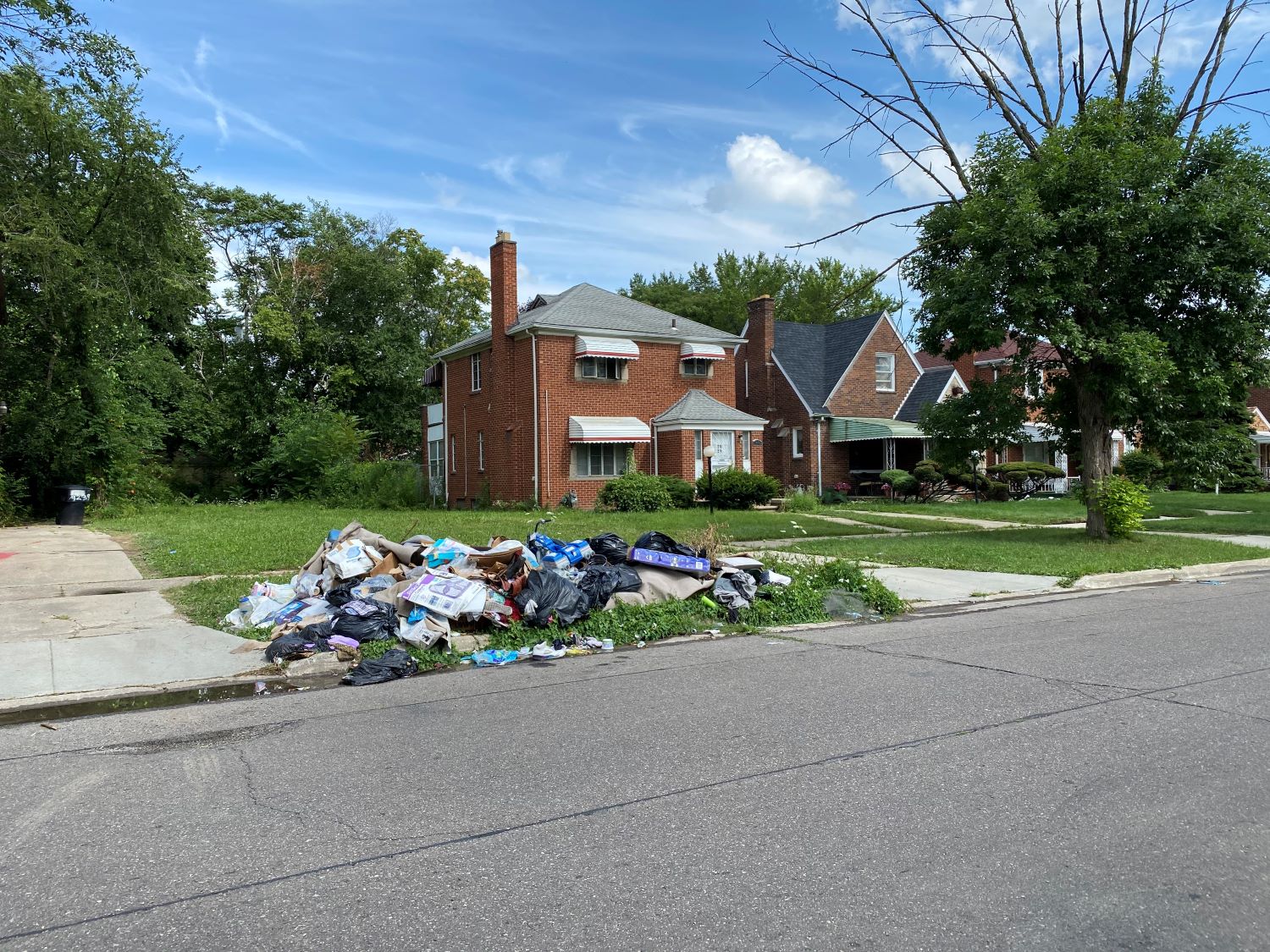Piper Carter has embarked on a journey, building community one step at a time. Located near west Chicago Blvd. and Schaefer, Carter and a few neighborhood allies are reconstituting the Hartwell Block Club.
Many people across our city are tired of waiting for city leadership to spur reinvestment in their impoverished communities. We know many are looking to organize neighborhood political power in the spirit of self-determination and self-reliance. The coronavirus pandemic has increased the difficulty of connecting with our neighbors, but it has also revealed economic, health, and political systems that are inherently corrupt.
We think Carter’s story, although far from complete, provides valuable lessons, traceable steps, and inspiration for those who are not trying to get out of their neighborhoods but would rather reimagine and reclaim it.
What follows is part I of a two-part series. Carter and the Hartwell Block Club recently received a commitment to assist in the cultivation of empty lots from the Detroit Black Farmer Land Fund, a sign that this story has only just begun.
— riverwise ed.
Part I
When I moved to my neighborhood in 2016, I searched for a block club to join for about three years. As a newcomer, I utilized all of the public-facing resources I could find to do research on the area. Just a basic Google search of my address and cross streets turned up mostly Zillow-type sites and lots of “crime” data. I input my zip code to search for my city council district and began researching from there. I learned that the district had been redrawn and I finally found the correct map. There was an older map from the Data-Driven Detroit website, which has taken up the task of self-identifying neighborhoods through collecting data. They have a tool you can use to find your neighborhood but it’s not really accurate for neighborhoods like mine that, through city divestment, have almost been erased. It’s more focused on the neighborhoods that have received heavy investment.
The city’s aggressive neighborhood divestment/investment plan, which lasted almost a decade, consisted of an entanglement with Skillman and Detroit Works, and the cutting off of public services and infrastructure to certain areas, creating Detroit Future City. Many residents, unfortunately, experienced a steady attack against their already historically and consistently underfunded communities.
Under NBA legend and former Mayor Dave Bing, the plan was initially called the “Right Sizing” plan. It was so-named because the goal was to make Detroit the “right size” by “shrinking” underpopulated neighborhoods in accordance with the population shift caused by folks moving from the city. This plan’s cuts to city services actually sped up the population decrease. At the same time (and continuing even now), we endured an aggressive campaign of city-led water shutoffs of affecting roughly one-third of the city’s residents, an aggressive closure of hundreds of schools, and a nefarious mortgage fraud spearheaded by Quicken Loans, who recently settled a lawsuit with the Justice Department over this issue.
(Mapping the Water Crisis, created by the We the People of Detroit Community Research Collective, is a great research project giving precise detailed information illustrating these intersections and their impact on the community.)
The egregious policy of shrinking the city led to 10,000 residents in my neighborhood experiencing the shutting off of street lights, limited garbage pick up and emergency services, the closing of the neighborhood high school, elementary school, hospital, community center, and as a consequence, businesses having to shut down, forcing many folks to have to move out of homes they owned and away from neighbors they had strong relationships with. It almost decimated the community.
This rhetoric of “cutting off services and infrastructure to areas that are almost empty” was a farce. Barton McFarlane neighborhood, along with many other neighborhoods across the city, became victims of this project that sought, “opportunities for the city to save resources and focus development efforts in healthier areas such as Midtown and Cass Corridor, the riverfront, downtown, and other ‘vital’ neighborhoods.” It also claimed “Detroit’s right-sizing program targets areas that have neither people nor intact buildings.” And it also claimed, “Some Detroit neighborhoods simply have nothing left to revitalize.”
Meeting Ms. Theo Broughton, President of the Barton McFarlane Neighborhood Association has been one of the highlights of my life. (There is a discrepancy in the spelling. If you look up the neighborhood on The Neighborhood App, the City’s website or Google it, McFarland is spelled with a “d”. The neighborhood association is spelled with an “e” and they insist that’s the correct spelling.) I met Ms. Theo in 2018 when I was invited to her house for a Hood Research meeting, an organization that focuses on political education. Ms. Theo also has a community radio show on Saturdays.
I had written an angry Facebook rant about the lack of bulk pick up on our block. I grew tired of continuously reporting on the Improve Detroit app and watching the Advanced Disposal truck pass over the same pile of bulk trash that had been there for about six months and kept growing on the empty lot on the corner. So, I posted a picture of it and wrote on it “This is Gabe Leland’s City Council District 7” and I wrote an accompanying post explaining the pile. I also included pictures of the disheveled garbage cans and debris that their workers had haphazardly thrown all over, up and down the street, using the mechanical arm to toss garbage into the back. I also noted that we have several houses with small children under the age of six and that this is a health hazard because they have to play outside in the garbage.
Through my experience as a community organizer and having owned a community space that I was violently gentrified out of, and having worked in the so-called activist and arts and culture communities in Detroit, nationally and globally, I have learned some skills to help me build community and relationships through deep listening and valuing local leadership.
What really made me start the block club was that I experienced an internal shift, or transformation, during a trip to the northeast of Brazil with members of Grassroots International. We had the opportunity to live with Indigenous communities, including the Afro-Indigenous Quilombo in the Amazon, who are fighting for their dignity and their way of life and their territories. I learned their very unique way of organizing through a framework and a process that we call a “united front”, where they were doing consistent political education in communities and villages. The folks from the communities lead the political education which includes an opening ritual honoring their ancestors they call a “mystica”, stories about their land and how they got there, their struggle for liberation, some aspect of political ideological theory broken down as a lesson, then a presentation of a current issue that needs to be addressed, and then organizing a plan and a team to address it. The hosting community usually gives a lesson on understanding their culture. And all of these gatherings are always followed by an incredible meal prepared by the hosting organization and usually some music or dancing
The focus of the organizing should be to understand the position of the state and that they are not one another’s enemies and that the violence that is being done to them is through the system of capitalism. They make sure folks are clear about the systems of patriarchy, racism, white supremacy, and anti-Blackness. I learned more about understanding the system of racialized capitalism and hetero-patriarchy through the many daily lessons I received being in these gatherings. I experienced them being under constant attack by the state, and when I shared my stories of how emergency management destroyed many people in Detroit, it resonated with many people because it mirrored circumstances in their struggle.
I witnessed the power of consistently opening with a spiritual grounding at the beginning of every single gathering, honoring ancestors, pouring libations, giving fruits and herbs and other gifts telling stories of the history of their people, the migration of their people, and how they got to the point where they are now. They always have a meal where everyone is bringing something to the table to share with folks, listening to other folks’ stories of their struggles, and what’s happening in their communities. This helps to build a lot of trust and camaraderie among people. That’s something that I really want to see in my community.
What I witnessed was people who live in close proximity to one another, who have positive relationships with one another, where folks are helping one another.
I decided when I got back that I wanted to mirror their organizing tactics and strategies because I saw with my own eyes the power that they were able to wield as a collective. They’re able to utilize this power doing consistent political education through frequent gatherings, learning about one another’s identities and cultures, and practices.
Piper Carter lives inside Detroit city. She is an Arts and Culture Organizer and Hip Hop activist with focus on Entertainment Justice, Environmental and Climate Justice, Education Justice, the Maker Space movement, and Food Justice communities. She is host of the Piper Carter Podcast on Detroit is Different where she discusses Social Justice and Hip Hop to a world wide audience.


